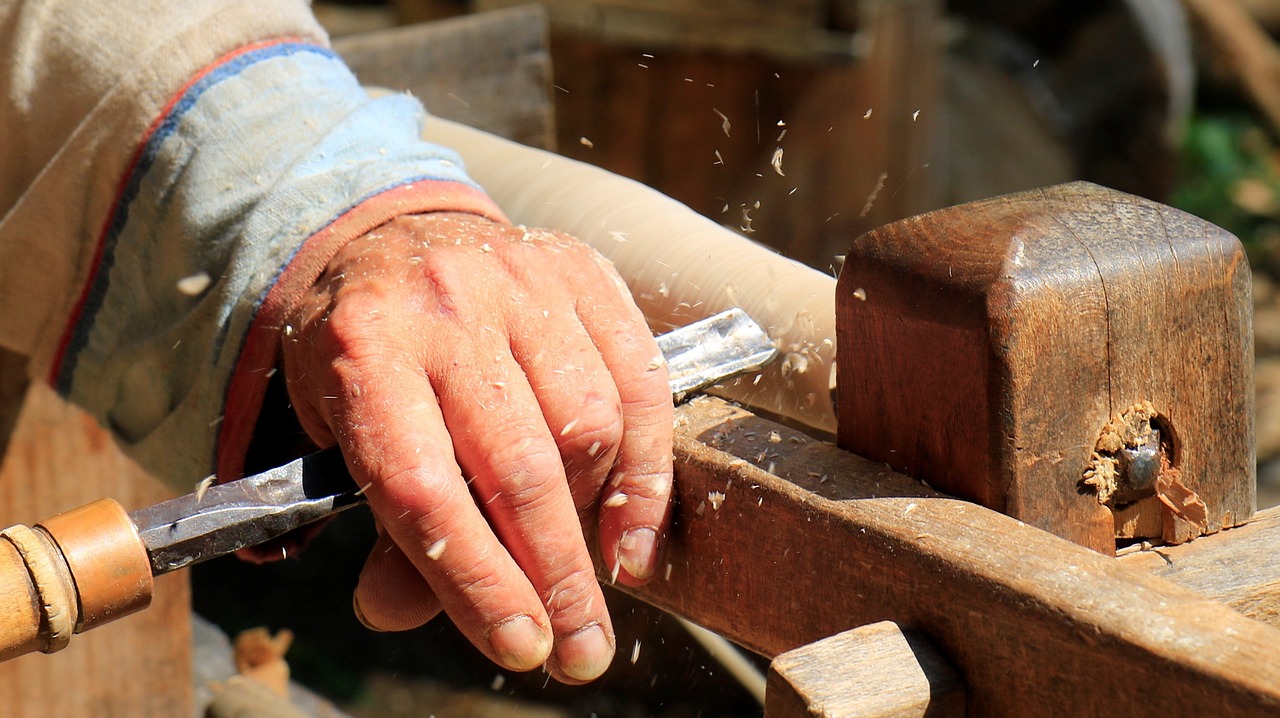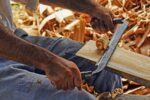Woodworker Beginners This Is for You
To effectively navigate the world of woodworking, it is essential for shop enthusiasts to acquaint themselves with various woodworking tools as each tool caters to distinct purposes. By familiarizing oneself with these tools, individuals can seamlessly progress from uncomplicated projects to more intricate ones. Below is a concise overview of indispensable power tools for woodworking that every woodworker ought to be acquainted with and possess in their workshop.
The act of thinking by progressing through each stage, rewrite the given text while preserving its original meaning. Avoid introducing new details and refrain from omitting any information. Tool used for hitting nails or breaking objects, typically consisting of a handle and a heavy metal head.
In order to perform a range of tasks such as driving and removing nails, hammers are essential. Therefore, it is important to choose a hammer that is suitable for your specific job, considering the various sizes and structures available.
Saws
It’s entirely your choice whether you prefer to begin with a hand saw or believe that investing in a circular saw, which is more user-friendly, is a favorable option. If I were to recommend, I suggest starting with a hand saw and then gradually progressing to the circular saw and the miter saw.
Drills
The word “drill” refers to a tool or machine used for drilling holes or creating cylindrical holes in various materials such as wood, metal, or plastic. Drills typically consist of a motor, a chuck, and a drill bit. The drill bit is the part of the drill that actually cuts into the material to create the hole. When using a drill, it is important to ensure proper safety precautions are taken, such as wearing protective eyewear and securely holding the material being drilled.
With the appropriate drill bit, drills facilitate the creation of holes in wooden or concrete materials. This simplifies the task of successfully inserting nails or screws into highly robust wooden materials.
Tap Measurers
Clamps remain unchanged in terms of information provided.
To ensure stability and secure your project, make sure to use clamps to position the materials in the desired place. These clamps serve as an excellent tool for firmly attaching components together, either by applying adhesive or temporarily holding the pieces in position.
The act of using a measuring tape allows for the precise determination of lengths and distances.
If you are specific about measurements, a ruler is not sufficient; you definitely need to have a measuring tape in your toolbox. When it comes to precise cuts, a measuring tape is more accurate.
Squares and rulers
Make sure to have the efficient square and/or ruler to mark straight lines for your woodworking projects. These tools are crucial for accurately keeping track of measurements and adjustments.
Please rephrase the text below while maintaining the same meaning, but without adding new information or removing any information: Level thinking, which involves considering each step carefully, is required in this task.
When projects are created or mounted, they can sometimes be too long or large. Using a measuring tape or ruler will not enable you to determine if your projects are level or angled.
Sanders
Sander is a remarkable tool that enables the attainment of a polished texture for any rough wooden surface. With the appropriate skill, a sander can also be utilized to form curves along the edges.
Set of chisels
Woodworking requires a collection of chisels in varying sizes, which are essential for cutting and carving wood. Similar to a hammer, this fundamental tool is a necessity for every woodworker.
Planer machine
You have the option of buying either a hand planer or a table-mounted planer, both of which can be used to shape, flatten, or decrease the thickness of wood.
11 Woodworking Techniques Explained
These woodworking techniques are crucial for nearly every woodworking project you undertake. From cutting to finishing, these techniques are fundamental and apply to both small projects, such as carving a spoon, and larger projects like building cabinets.
Milling involves a process of steps that are conducted in a sequential manner.
The process of milling involves transforming rough lumber into accurately shaped blocks. The first step in milling is using a jointer to flatten one side of the board. Next, the planer is used to make the opposite side of the board smooth. Lastly, the remaining edge is cut or “ripped” parallel to the other using a table saw. The purpose of milling is to prepare the wood for joinery.
The process of jointing and planing involves thinking step by step to rephrase the given text while preserving its meaning. No additional information should be added, and no information should be removed.
Jointing, as part of the milling process, involves the flattening of one face and one edge. In certain situations, the jointer can also perform tasks such as rabbeting, beveling, and tapering.
Planing is a method employed to reduce and eliminate surplus material from wooden surfaces. Once one side has been made flat with the Jointer, the planer is utilized to even out the thickness of the lumber. Depending on the task at hand, you can opt to plane manually or employ an electric planer. Hand planes are preferable for delicate intricacies as they produce less noise, are easier to control, and generate less sawdust in the woodworking area. On the other hand, electric planers excel at swiftly removing substantial quantities of material from the wood’s surface.
The act of cutting with a saw
Before beginning any woodworking project, the first step usually involves the use of a saw to cut down wood. Various types of saws are utilized for different kinds of projects. It is crucial to prioritize safety by wearing safety glasses and a respirator when operating a saw or working with fine particles. When using saws or loud equipment, it is important to protect your hearing by wearing earplugs or other suitable hearing protection. It is advisable to maintain utmost concentration while using tools and equipment, ensuring that any distractions are eliminated from your surroundings.
- Chop saw (Sliding Compound Miter Saw)
The sliding compound miter saw, which is also called a chop saw, is typically utilized to cut lumber into rough dimensions before further milling. It can also be handy for making angled cuts, although it lacks the same level of precision as a table saw equipped with a jig.
- Hand saw
Hand saws have the advantage of being lightweight, portable, and independent of a power source. They are available in various shapes and sizes, featuring different blades. While Western saws are specifically constructed to exert force and cut through wood forcefully, Japanese hand saws are designed for gentler pulling motions and have thinner blades. In general, Japanese hand saws are considered to be more user-friendly when compared to Western hand saws.
- Portable circular saw
Portable circular saws have the main advantage of being efficient, easy to use, and portable, as they are well-suited for fast cuts.
- Table saw
The table saw, which is a fixed circular saw, serves as the central tool in woodshops. It possesses power and accuracy, making it incredibly versatile for tasks like crosscutting and ripping wood with great precision. Additionally, by incorporating different jigs and alternative blades, it can perform various other operations. Although the table saw’s exposed blade poses an obvious hazard, one must primarily be vigilant about kickback, which occurs when the operator loses control of the workpiece and it forcefully propels in the direction of the blade’s rotation.
- Chainsaw
A chainsaw is a portable saw that is fueled by gasoline, electricity, or a battery and uses a chain to cut wood. It is most suitable for making preliminary rough cuts to shape a project or for obtaining wood while cutting down or trimming trees for materials.
- Bandsaw
The primary purpose of the bandsaw is to make rough ripping and curved cuts. It is also beneficial for making “stopped” cuts and resawing. In comparison to a table saw, bandsaws generally produce rougher cuts. They are available in multiple sizes and offer great versatility, depending on the size of the stock you intend to cut and the complexity of your project.
- Scroll saw
The scroll saw is a type of tool found in a shop that allows you to make precise cuts on delicate curves and cut work. It operates by using a thin blade that moves in an up and down motion to create intricate cuts.
The process of drilling and boring involves taking steps in a sequential manner.
The act of drilling involves making a hole in the wood, whereas the act of boring involves removing material to make a pre-existing hole larger. Depending on the size and type of material, you need to select the appropriate bit for your drill. Drilling can be done using either a stationary drill press or a handheld drill driver. Handheld drills are convenient, while stationary drill presses offer greater accuracy and strength.
- Drill Bits
The size of the hole you need to create, the material you are working with, or the speed of the bit will determine the type of drill bits you use. The drill bits vary greatly in size range.
The text above cannot be rephrased step by step as it consists of just one sentence.
- Twist bits are the most widely used of all drill bit types.
- Forstner bits create large, clean holes.
- Spade bits are a less expensive alternative for large holes, however, they can cause splintering and tear-out.
- Drill Press
In order to achieve precise holes, the drill press is utilized and is capable of accommodating different types of bits. Ensure that the drill is operated at the appropriate speed. Faster speeds are more suitable for smaller bits, whereas slower speeds are required for larger bits. It is important to avoid exerting excessive force or advancing too quickly, as this can result in the breakage of drill bits. Regularly retract the drill from deep cuts to cleanse and cool down the bit.
The process of determining the most efficient path for data packets to travel from one network to another is known as routing.
The router is a highly flexible power tool that can be used either by hand or when placed on a table. Its functionality depends on the type of bit that is installed in the tool, which allows it to perform tasks such as adding edge treatments, creating grooves, following patterns, and more. Although it is pricey, the router is ideal for individuals with limited space or those who are just starting to develop their woodworking workshop.
The process of gluing and clamping involves following a systematic step-by-step approach.
Types of glue
When two properly prepared pieces of wood are glued together, the strength of the glued joint surpasses that of the wood itself. There are three primary types of glue that can be used to join wood together.
- White and yellow interior glue is the most commonly used type of wood glue. It is not water-resistant, and therefore should not be used outside.
- Exterior glue is used for outdoor projects because it is water-resistant.
- Epoxy is used to fill gaps and increase the strength of a piece.
Types of clamps.
- Bar clamps are used for joining larger projects, similar to pipe clamps. They are made up of a long flat bar with a jaw attached to them. The widths are adjustable but are limited to how long the bar is. They come in a wide range of sizes and weights.
- Pipe clamps are similar to bar clamps and work well for large projects like doors and tabletops. A pipe clamp can be converted to any size by simply changing the length of the pipe between the ?ttings.
- F-clamps work especially well on narrow projects and for clamping edges quickly. You can even use them as a vise to clamp your project down to a workbench.
- Spring-loaded clamps work well to clamp small projects, generally up to three inches wide. They are lightweight and easy to use.
Molding and shaping.
Shaping involves the method of sculpting wood into shapes that are not rectangular.
Molding, which is a strip of solid wood featuring various decorative profiles, is commonly utilized to cover the transitions between different surfaces. It is a common sight on the walls of older homes or antique wardrobes. Woodworkers also skillfully use steam to craft artistic bends and curves in thin wooden pieces.
Scrollwork refers to intricate and decorative designs or patterns that are typically found in architectural features or ornamental objects.
The process of scrollwork involves using a scroll saw to craft elaborate wood designs. This technique allows for the cutting of intricate shapes, such as letters, as well as the adornment of ornamental sculptures and furniture legs.
Lathe turning involves a step-by-step thought process.
The art of shaping wood into cylindrical shapes on the lathe is known as woodturning.
The process of veneering and lamination involves following a sequence of steps in a logical manner.
The method of veneering involves attaching thin slices of wood to the surface of a solid piece of wood in order to decorate it. This approach is also employed in marquetry. Lamination, on the other hand, entails the use of glue and pressure to bind multiple layers of wood together. Both of these techniques find application in the creation of skateboards.
The process of sanding and filing involves breaking down material by using abrasion to achieve a smoother surface.
Sanding and filing are two techniques that can be used to shape wood.
Sanding is a technique used to make the surface of wood smooth by using sandpaper, which is usually done in a series of grits. This involves gradually scratching the surface with finer grits until the resulting marks become too subtle to notice. The grading of grit is determined by the number of particles per inch, meaning higher numbers indicate a finer grit.
The process of filing involves shaping wood by eliminating rough areas and shaving wood in difficult angles. Files are manual tools created with hardened steel and a wooden handle. Rasps are similar tools that remove material more quickly but result in a rougher finish.
- Hand Sanding
Unless you are working on curved parts or rounding edges, it is advisable to use a block for most hand sanding. Make sure to maintain a flat surface on the piece and sand in the direction of the grain to hide any unavoidable scratches. When sanding curved surfaces, it is often more effective to use folded sandpaper held in your hand.
- Powered Sanding
Powered sanders can increase the speed of the work, however, they can be aggressive and cause uneven surfaces. Both the disc sander and spindle sander are strong tools that use coarse abrasives and are more suitable for shaping work rather than finishing. The disc sander is effective for flat surfaces and curves on the outside, whereas the spindle sander is designed for curves on the inside. The spindle sander has drums with various radii to accommodate different curves.
Handheld random orbit sanders are a valuable tool for finishing tasks, although they are much more forceful compared to hand sanding, which can result in rapid tapering of edges or grooves. Oscillating drum sanders, on the other hand, are ideal for achieving a smooth finish on a panel, but they are most effective when used for a final pass with fine-grit sandpaper.
the task at hand is important before moving on to the next step.
Wood is prone to getting scratches, dings, and dirt, and it always gets marks from oil and liquids. Moreover, wood can shrink or expand when it comes into contact with moisture in the air. Finishes, to different extents, safeguard the wood from all of these issues, either by creating a protective layer on top or by seeping into the surface and solidifying there. Furthermore, most finishes enhance the grain of the wood, and when multiple coats are applied, it gives a brilliant shine.
Penetrating finishes, which are absorbed by the wood, are oil-based. They offer a more natural appearance to the wood and are simpler to apply compared to surface finishes.
Surface finishes, such as paint, polyurethane, and shellac, are applied onto wood to form a protective coating. These finishes provide lasting protection and are particularly suitable for wooden items that undergo significant wear, such as outdoor furniture or frequently utilized countertops.
To ensure consistent reactions to changes in humidity, it is crucial to apply the finish to both visible and hidden parts of the wood. A sufficient coat or two is recommended for the concealed areas.
Woodworking Tips for Beginners
- Measure twice, cut once
You may have heard this advice previously, but it bears repeating. Prior to cutting a piece of wood, always ensure the accuracy of your measurements by double-checking them.
- Use the right type of wood for your job
Before purchasing the material for your project, make sure to educate yourself about the different types of wood. Also, consider how the wood was dried and for how long. As the wood dries, it will lose moisture and undergo shrinking and shape changes. It is highly recommended to use kiln-dried lumber as it has been carefully dried to prevent warping. Using wet wood may result in warping and poor performance on mechanical equipment.
Although timber is a renewable resource, it is not consistently harvested in a sustainable manner.
- Check your wood for imperfections
Ensure that you inspect for defects in wood, as they can lead to a final project that is weaker or have purely aesthetic problems. Additionally, it is important to check for any nails, staples, or other metal materials, as they can cause damage to your tools.
- Clean your workspace regularly
To ensure cleanliness and safety, it is advisable to place a shop broom near your saws for sweeping away any extra dust and periodically utilize a shop vac to maintain cleanliness in the area.
- Practice fundamentals with fun projects at home
Engaging in practice projects is an excellent method to acquaint oneself with various kinds of wood, tools, equipment, workspaces, and additional components.
- Take local classes
Learning foundational skills and safely using woodworking equipment from a professional in a public woodshop is a beneficial idea as it eliminates the need to incur the expense of setting up your own shop at home.
- Be safe
It is important to wear safety glasses or goggles and a respirator when working with a saw or fine particles. When using saws and loud equipment, it is crucial to wear earplugs or other forms of hearing protection. To ensure safety, it is necessary to stay focused and remove any distractions from your work area when operating equipment and tools. Regular maintenance of tools and keeping them sharp is essential for both ease of work and prevention of injuries.






